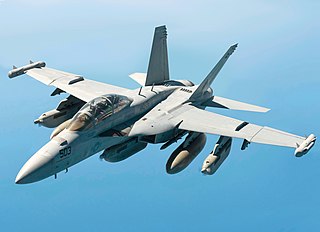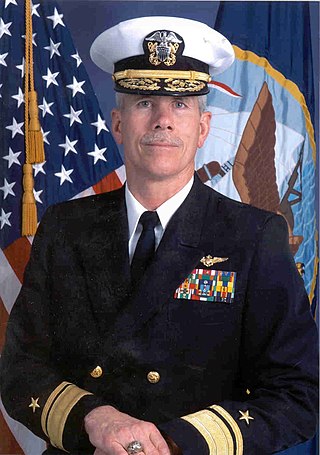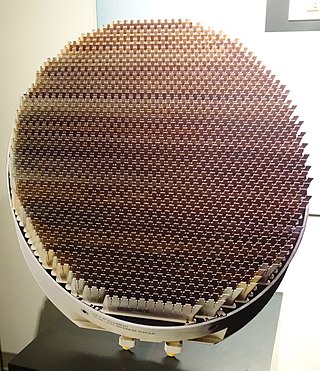
The AGM-88 HARM is a tactical, air-to-surface anti-radiation missile designed to home in on electronic transmissions coming from surface-to-air radar systems. It was originally developed by Texas Instruments as a replacement for the AGM-45 Shrike and AGM-78 Standard ARM system. Production was later taken over by Raytheon Corporation when it purchased the defense production business of Texas Instruments.

The McDonnell DouglasF-15E Strike Eagle is an American all-weather multirole strike fighter derived from the McDonnell Douglas F-15 Eagle. The F-15E was designed in the 1980s for long-range, high-speed interdiction without relying on escort or electronic-warfare aircraft. United States Air Force (USAF) F-15E Strike Eagles can be generally distinguished from other US Eagle variants by darker aircraft camouflage, conformal fuel tanks (CFTs) mounted along the engine intake ramps and a tandem-seat cockpit.

The Boeing EA-18G Growler is an American carrier-based electronic warfare aircraft, a specialized version of the two-seat Boeing F/A-18F Super Hornet. The EA-18G replaced the Northrop Grumman EA-6B Prowlers in service with the United States Navy. The Growler's electronic warfare capability is primarily provided by Northrop Grumman. The EA-18G began production in 2007 and entered operational service with the US Navy in late 2009. Australia has also purchased thirteen EA-18Gs, which entered service with the Royal Australian Air Force in 2017.

An active electronically scanned array (AESA) is a type of phased array antenna, which is a computer-controlled antenna array in which the beam of radio waves can be electronically steered to point in different directions without moving the antenna. In the AESA, each antenna element is connected to a small solid-state transmit/receive module (TRM) under the control of a computer, which performs the functions of a transmitter and/or receiver for the antenna. This contrasts with a passive electronically scanned array (PESA), in which all the antenna elements are connected to a single transmitter and/or receiver through phase shifters under the control of the computer. AESA's main use is in radar, and these are known as active phased array radar (APAR).

The Boeing F/A-18E and F/A-18F Super Hornet are a series of American supersonic twin-engine, carrier-capable, multirole fighter aircraft derived from the McDonnell Douglas F/A-18 Hornet, in service with the armed forces of the U.S., Australia, and Kuwait. The F/A-18E single-seat and F/A-18F tandem-seat variants are larger and more advanced versions of the F/A-18C and D Hornet, respectively.

James Basil "Gib" Godwin III, a retired Rear Admiral of the United States Navy, was the Program Executive Officer – Enterprise Information Systems of the Department of the Navy. His responsibilities included oversight of the Navy/Marine Corps Intranet.
Northrop Grumman Electronic Systems (NGES) was a business segment of Northrop Grumman from 1996 to 2015 until a reorganization on January 1, 2016, merged other Northrop Grumman businesses into NGES to form a new segment called Mission Systems. NGES had originally been created by Northrop Grumman's acquisition of Westinghouse Electronic Systems Group in 1996. The Electronic Systems sector was a designer, developer, and manufacturer of a wide variety of advanced defense electronics and systems. The division had 120 locations worldwide, including 72 international offices, and approximately 24,000 employees; accounting for 20% of company sales in 2005.

The AN/APG-63 and AN/APG-70 are a family of all-weather multimode radar systems designed by Hughes Aircraft for the F-15 Eagle air superiority fighter. These X band pulse-Doppler radar systems are designed for both air-air and air-ground missions; they are able to look up at high-flying targets and down at low-flying targets without being confused by ground clutter. The systems can detect and track aircraft and small high-speed targets at distances beyond visual range down to close range, and at altitudes down to treetop level. The radar feeds target information into the aircraft's central computer for effective weapons delivery. For close-in dogfights, the radar automatically acquires enemy aircraft and projects this information onto the cockpit head-up display. The name is assigned from the Army Navy Joint Electronics Type Designation System.
The AN/APG-65 and AN/APG-73 are designations for a family of all-weather multimode airborne radar systems designed by Hughes Aircraft for the F/A-18 Hornet, and used on a variety of fighter aircraft types. The APG-79 is an upgraded AESA version.

The AN/APG-77 is a multifunction low probability of intercept radar installed on the F-22 Raptor fighter aircraft. The radar was designed and initially built by Westinghouse and Texas Instruments, and production continued with their respective successors Northrop Grumman and Raytheon after acquisition.
The AN/APG-80 is an Active Electronically Scanned Array (AESA) system designed and manufactured by Northrop Grumman for use on the Lockheed Martin F-16 Fighting Falcon fighter aircraft. It was originally designed to be included on the F-16C/D Block 60 Desert Falcon aircraft ordered by the United Arab Emirates, subsequently reclassified as the F-16E/F Block 60 Desert Falcons; first deliveries were made in 2003.

The AN/APG-81 is an active electronically scanned array (AESA) fire-control radar system designed by Northrop Grumman Electronic Systems for the Lockheed Martin F-35 Lightning II.
The AN/APG-83 Scalable Agile Beam Radar (SABR) is a full-performance active electronically scanned array (AESA) fire control radar for the General Dynamics F-16 Fighting Falcon and other aircraft developed by Northrop Grumman. In a 2013 competition, Lockheed Martin selected SABR as the AESA radar for the F-16 modernization and update programs of the United States Air Force and Republic of China Air Force. 5th Generation Fighter Radar Capability for the 4th Gen Aircraft. The SABR APG-83 is an Active Electronically Scanned Array (AESA) fire control radar.
F/A-XX is a development and acquisition program for a future sixth-generation air superiority fighter to replace the United States Navy's F/A-18E/F Super Hornet and complement the F-35C beginning in the 2030s. A requirement was first identified in June 2008.

The AN/SPY-6 is an active electronically scanned array 3D radar under development for the United States Navy (USN). It will provide integrated air and missile defense for Flight III Arleigh Burke-class destroyers. Variants are under development for retrofitting Flight IIA Arleigh Burkes and for installation aboard Constellation-class frigates, Gerald R. Ford-class aircraft carriers, America-class amphibious assault ships, and San Antonio-class amphibious transport docks.
The Next Generation Jammer is a program to develop an airborne electronic warfare system, as a replacement for the AN/ALQ-99 found on the EA-18G military aircraft. It reached Initial Operating Capability in 2021.
Cooperative Engagement Capability (CEC) is a sensor network with integrated fire control capability that is intended to significantly improve battle force air and missile defense capabilities by combining data from multiple battle force air search sensors on CEC-equipped units into a single, real-time, composite track picture. This will greatly enhance fleet air defense by making jamming more difficult and allocating defensive missiles on a battle group basis.
The Long Range Discrimination Radar(LRDR) in Alaska is part of the United States's Ground-Based Midcourse Defense anti-ballistic missile system. The main contractor is Lockheed Martin, under a US$784 million contract from the Missile Defense Agency in October 2015.
SCIFIRE or the Southern Cross Integrated Flight Research Experiment is an American-Australian military technology partnership that is developing a solid-rocket boosted, air-breathing, hypersonic conventional cruise missile that can be launched by existing fighter or bomber aircraft.










